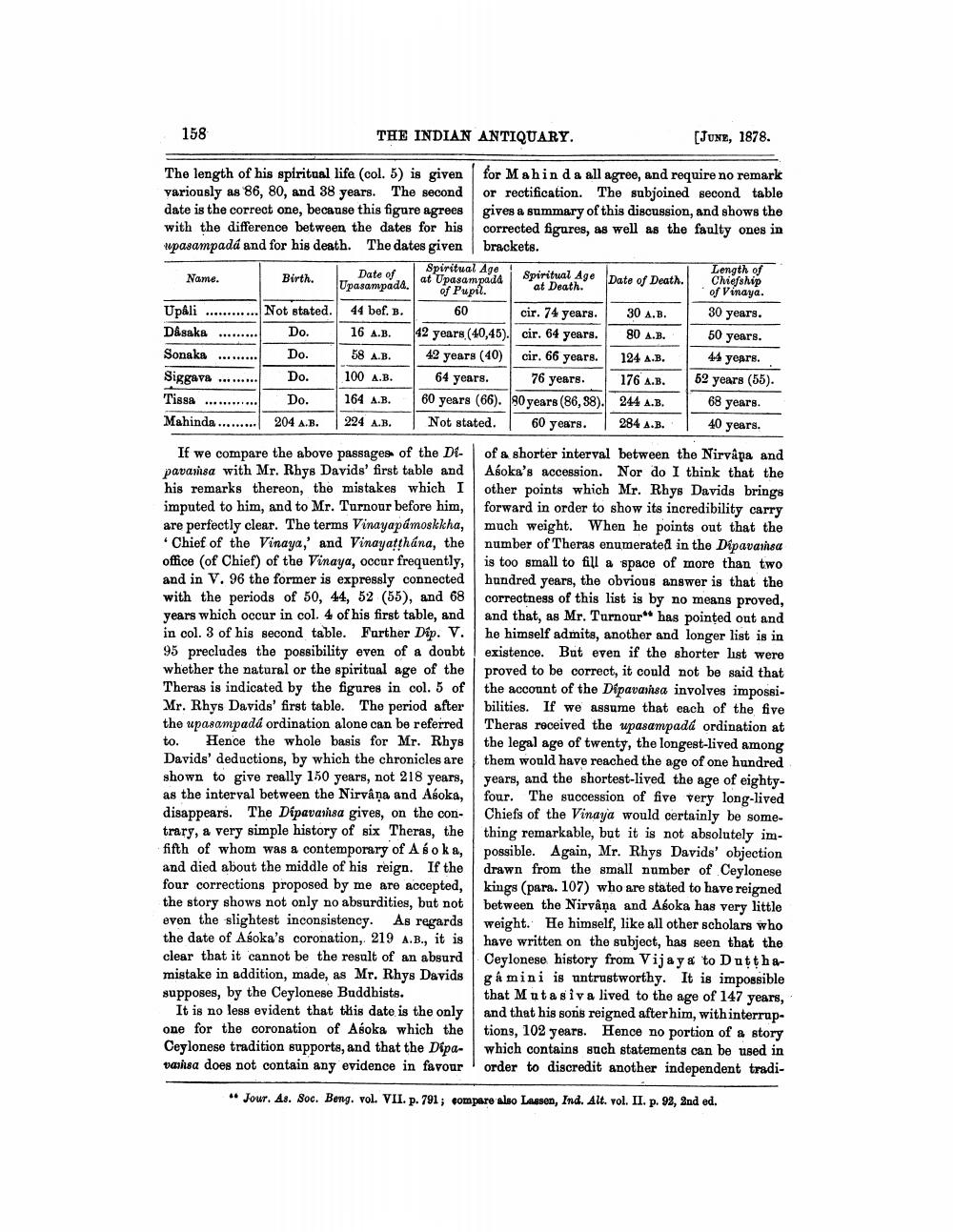________________
158
The length of his spiritual life (col. 5) is given variously as 86, 80, and 38 years. The second date is the correct one, because this figure agrees with the difference between the dates for his upasampadá and for his death. The dates given
Birth.
Name.
Upâli
Dâsaka
Sonaka
Siggava
Tissa
Mahinda.
THE INDIAN ANTIQUARY.
Not stated.
Do.
Do.
Do.
Do.
204 A.B.
Date of Upasampada.
44 bef. B. 16 A.B.
58 A.B.
100 A.B.
164 A.B.
224 A.B.
[JUNE, 1878.
for Mahinda all agree, and require no remark or rectification. The subjoined second table gives a summary of this discussion, and shows the corrected figures, as well as the faulty ones in brackets.
Spiritual Age at Upasampada of Pupil. 60
42 years (40,45). 42 years (40) 64 years.
60 years (66). Not stated.
If we compare the above passages of the Dipavamsa with Mr. Rhys Davids' first table and his remarks thereon, the mistakes which I imputed to him, and to Mr. Turnour before him, are perfectly clear. The terms Vinayapámoskkha, 'Chief of the Vinaya,' and Vinayaṭṭhána, the office (of Chief) of the Vinaya, occur frequently, and in V. 96 the former is expressly connected with the periods of 50, 44, 52 (55), and 68 years which occur in col. 4 of his first table, and in col. 3 of his second table. Further Dip. V. 95 precludes the possibility even of a doubt whether the natural or the spiritual age of the Theras is indicated by the figures in col. 5 of Mr. Rhys Davids' first table. The period after the upasampada ordination alone can be referred Hence the whole basis for Mr. Rhys Davids' deductions, by which the chronicles are shown to give really 150 years, not 218 years, as the interval between the Nirvâna and Aśoka, disappears. The Dipavamsa gives, on the contrary, a very simple history of six Theras, the fifth of whom was a contemporary of A é o ka, and died about the middle of his reign. If the four corrections proposed by me are accepted, the story shows not only no absurdities, but not even the slightest inconsistency. As regards the date of Asoka's coronation, 219 A.B., it is clear that it cannot be the result of an absurd mistake in addition, made, as Mr. Rhys Davids supposes, by the Ceylonese Buddhists.
to.
It is no less evident that this date is the only one for the coronation of Asoka which the Ceylonese tradition supports, and that the Dipavassa does not contain any evidence in favour
Spiritual Age Date of Death.
at Death.
cir. 74 years. cir. 64 years. cir. 66 years. 76 years. 80 years (86, 38). 60 years.
30 A.B.
80 A.B.
124 A.B.
176 A.B.
244 A.B. 284 A.B.
Length of Chiefship of Vinaya.
30 years.
50 years.
44 years.
52 years (55).
68 years. 40 years.
of a shorter interval between the Nirvâpa and Aśoka's accession. Nor do I think that the other points which Mr. Rhys Davids brings forward in order to show its incredibility carry much weight. When he points out that the number of Theras enumerated in the Dipavamsa is too small to fill a space of more than two hundred years, the obvious answer is that the correctness of this list is by no means proved, and that, as Mr. Turnour** has pointed out and he himself admits, another and longer list is in existence. But even if the shorter list were proved to be correct, it could not be said that the account of the Dipavansa involves impossibilities. If we assume that each of the five Theras received the upasampadá ordination at the legal age of twenty, the longest-lived among them would have reached the age of one hundred years, and the shortest-lived the age of eightyfour. The succession of five very long-lived Chiefs of the Vinaya would certainly be something remarkable, but it is not absolutely impossible. Again, Mr. Rhys Davids' objection drawn from the small number of Ceylonese kings (para. 107) who are stated to have reigned between the Nirvana and Aśoka has very little weight. He himself, like all other scholars who have written on the subject, has seen that the Ceylonese history from Vijaya to Duṭṭhagamini is untrustworthy. It is impossible that Mutasiva lived to the age of 147 years, and that his sons reigned after him, with interruptions, 102 years. Hence no portion of a story which contains such statements can be used in order to discredit another independent tradi
Jour. As. Soc. Beng. vol. VII. p. 791; compare also Lassen, Ind. Alt. vol. II. p. 92, 2nd ed.




